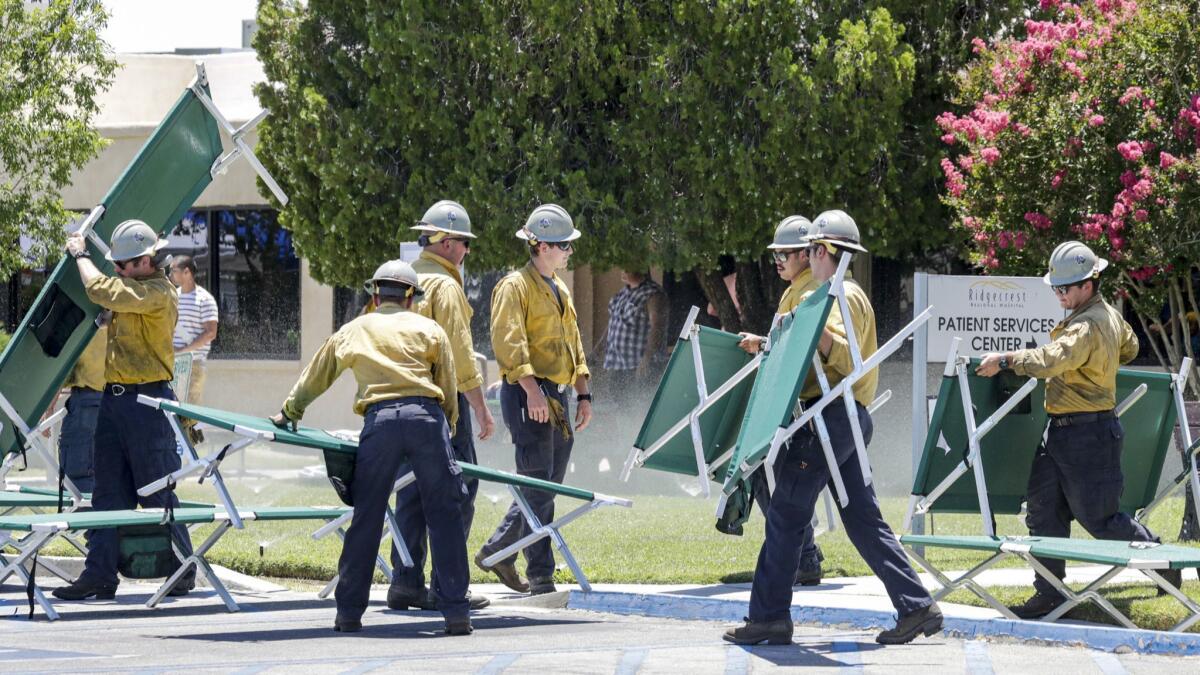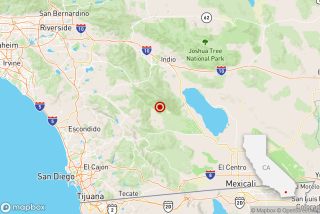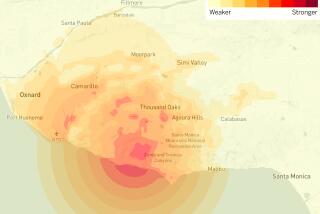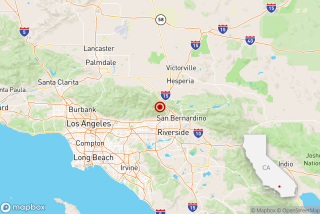Ridgecrest earthquake was intense. Exactly how strong was it?

The Fourth of July Ridgecrest earthquake measured 6.4 magnitude.
It was the strongest quake to hit Southern California in years, but it was actually significantly less powerful than some earlier temblors.
That includes the 6.7 Northridge quake in 1994 (which was 2.8 times stronger than Thursday’s earthquake) and the 7.1 Hector Mine quake in the Mojave Desert in 1999 (11 times stronger).
Caltech seismologist Egill Hauksson estimated it was the most widely felt quake in Southern California since the 7.2 Mexicali temblor in 2010.
Quakes are measured by magnitude — a measure of how much energy it produced. They’re also measured by intensity — how strong of a shake did people feel from a temblor.
In Thursday’s quake, severe shaking was felt in a remote region of the Mojave Desert; in Los Angeles County, by contrast, only weak or light shaking was felt.
FULL COVERAGE: 6.4 July 4 Southern California earthquake »
Here is a primer on these seismic measurements from the pages of The Times:
How magnitude works
For each whole number increase in magnitude, the seismic energy released increases by about 32 times. That means a magnitude 7 earthquake produces 32 times more energy — or is 32 times stronger — than a magnitude 6.
A magnitude 8 releases 1,000 times more energy than a magnitude 6, but it releases that energy over a larger area and for a longer time, according to seismologist Lucy Jones of Caltech.
Originally, the definition of magnitude related to seismograms, in which machines used an ink stylus to record rapid motions on a rolling drum of paper that would measure shaking. Magnitude was about how big the waves were on a seismogram at a particular distance from the epicenter. On the so-called Richter scale, a magnitude 8 on a seismogram was 10 times bigger than a magnitude 7.
Why L.A.’s early warning system didn’t send an alert before the magnitude 6.4 quake »
But the Richter scale was eventually scrapped in favor of what is known as the moment magnitude scale. The moment magnitude scale measures the movement of rock along the fault and accurately measures larger earthquakes, which can last for minutes and affect a much larger area; the Richter scale did not accurately record such quakes, Jones said.
The U.S. Geological Survey has a calculator that can help you make these calculations. So for instance, a magnitude 8.2 — probably the strongest earthquake that could hit Southern California on the San Andreas fault — would produce an astonishing 178 times more energy than the Northridge earthquake in 1994.
That earthquake was a magnitude 6.7. But the shaking intensity varied by where you were when it hit.
If you were in Northridge, right on top of where the earthquake fault moved, you faced what’s known as intensity 9 shaking, defined by the Modified Mercalli Intensity scale as “violent” — enough to shift a structure off its foundation.
Yet the downtown Los Angeles region got far less intense shaking from the same earthquake — intensity 6 or 7, where damage is negligible in buildings of good design and construction.
Strongest earthquake in years rattles Southern California; damage reported »
On Thursday, communities near the epicenter saw damage. But closer to L.A., there was shaking but no damage.
The size was one reason. Another was the distance. The epicenter Thursday was 100 miles from Los Angeles. Northridge’s epicenter was right under the suburban San Fernando Valley.
Intensity scale
The USGS has a Modified Mercalli Intensity Scale that allows scientists to quantify how much shaking is felt at any particular location.
A USGS map shows how the worst shaking — intensity level 8, or “severe” shaking occurred in a remote area of the Mojave Desert. Ridgecrest, a city of about 29,000 people, endured intensity level 6, or strong shaking, while Los Angeles County observed only intensity level shaking in the 2 to 4 range, considered just weak or light.
Here is a USGS explanation of how that works.
Intensity 10: Extreme — Some well-built wooden structures destroyed; most masonry and frame structures destroyed with foundations. Rails bent.
Intensity 9: Violent — Damage considerable in specially designed structures; well-designed frame structures thrown out of plumb. Damage great in substantial buildings, with partial collapse. Buildings shifted off foundations.
Intensity 8: Severe — Damage slight in specially designed structures; considerable damage in ordinary substantial buildings with partial collapse. Damage great in poorly built structures. Fall of chimneys, factory stacks, columns, monuments, walls. Heavy furniture overturned.
Expect more earthquakes, possibly even stronger ones, seismologists say »
Intensity 7: Very strong — Damage negligible in buildings of good design and construction; slight to moderate in well-built ordinary structures; considerable damage in poorly built or badly designed structures; some chimneys broken.
Intensity 6: Strong — Felt by all, many frightened. Some heavy furniture moved; a few instances of fallen plaster. Damage slight.
Intensity 5: Moderate — Felt by nearly everyone; many awakened. Some dishes, windows broken. Unstable objects overturned. Pendulum clocks may stop.
Intensity 4: Light — Felt indoors by many, outdoors by few during the day. At night, some awakened. Dishes, windows, doors disturbed; walls make cracking sound. Sensation like heavy truck striking building. Standing cars rocked noticeably.
Intensity 3: Weak — Felt quite noticeably by people indoors, especially on upper floors of buildings. Many people do not recognize it as an earthquake. Standing cars may rock slightly. Vibrations similar to the passing of a truck. Duration estimated.
Intensity 2: Weak — Felt only by a few people at rest, especially on upper floors of buildings.
Intensity 1: Not felt — Not felt except by a very few under especially favorable conditions.
More to Read
Start your day right
Sign up for Essential California for news, features and recommendations from the L.A. Times and beyond in your inbox six days a week.
You may occasionally receive promotional content from the Los Angeles Times.







